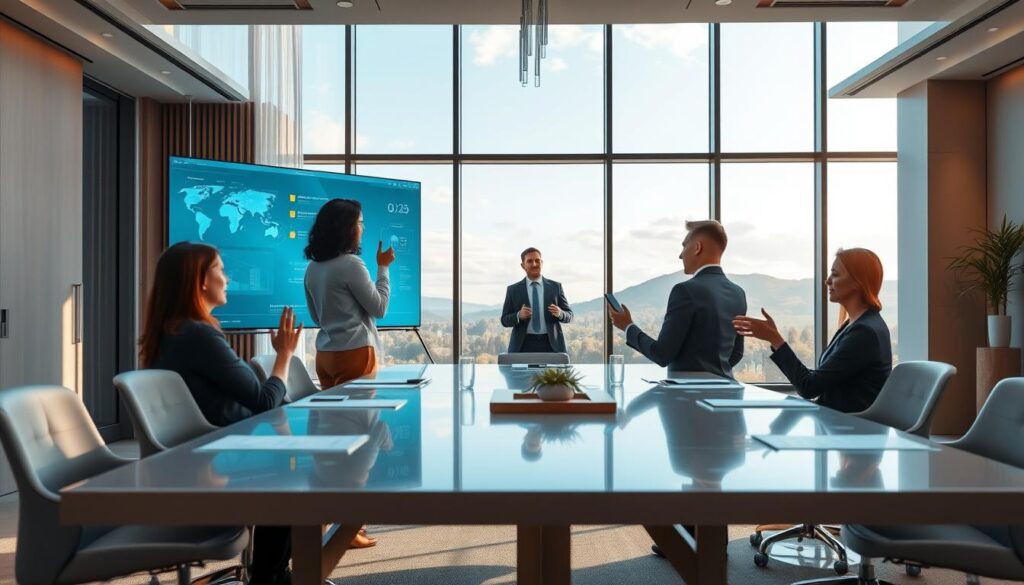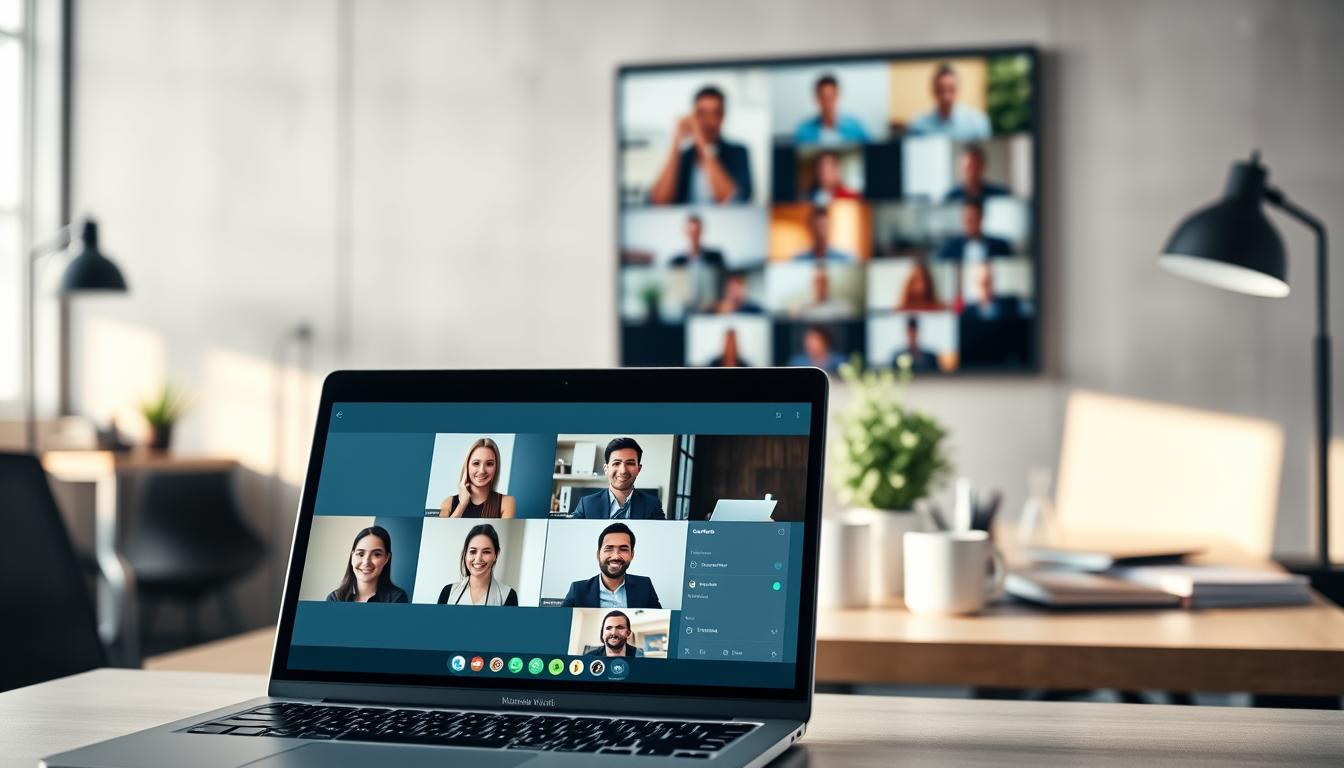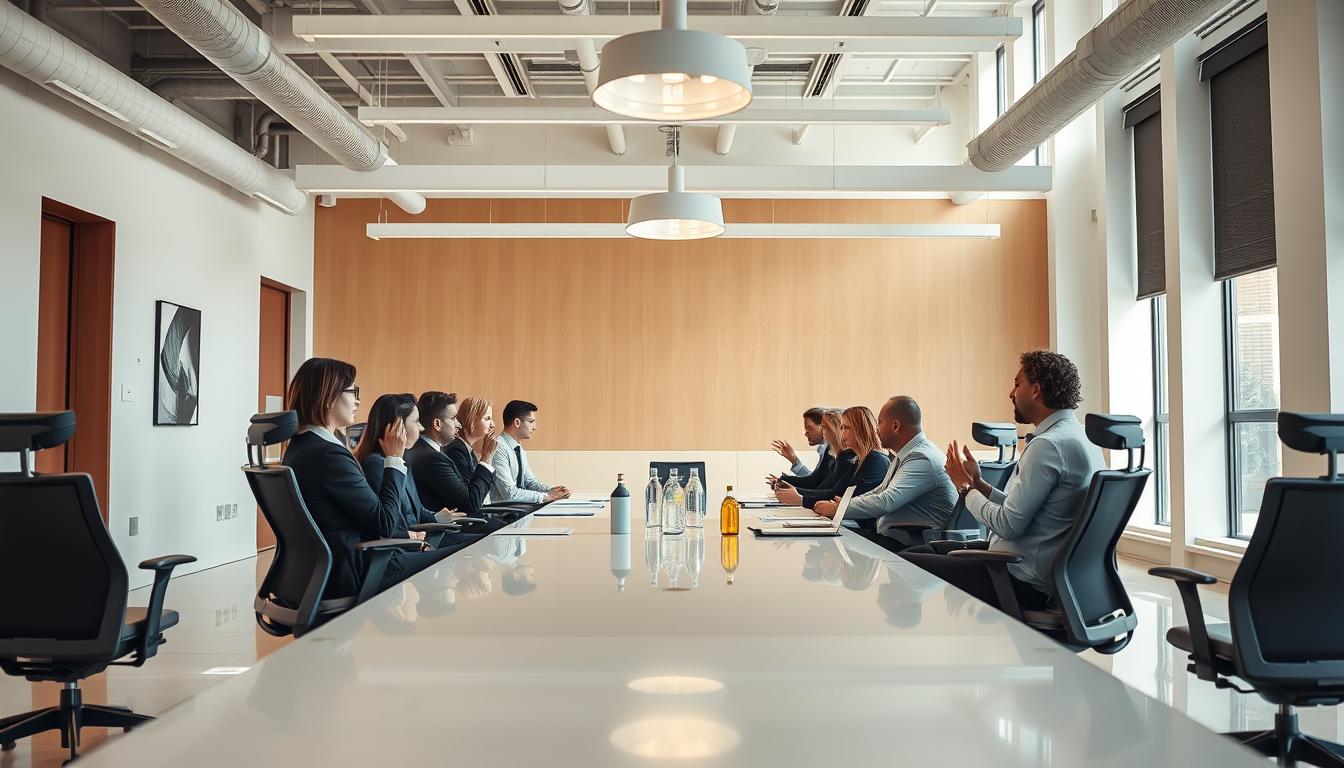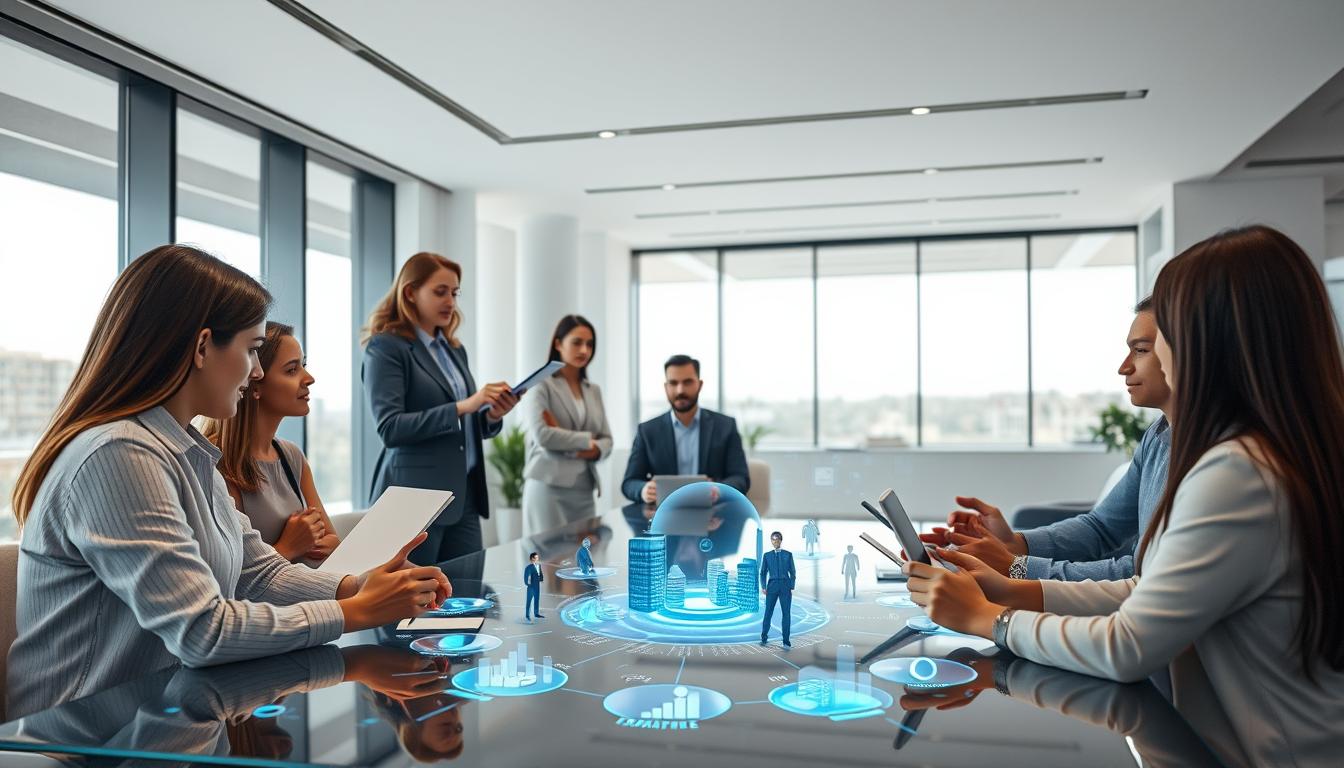In today’s fast-paced business world, businesses often struggle with meetings that just don’t work well. These bad meetings can really hurt productivity and make employees unhappy. It’s critical to find better ways to hold meetings.
By using smart meeting strategies, companies can change their meetings for the better. This approach leads to discussions that are both helpful and goal-driven. Learn how to make your meetings more productive and create a workplace where everyone feels involved and responsible.
The Consequences of Unproductive Meetings
Unproductive meetings hurt organizations by causing financial loss and making employees unhappy. Companies spend a lot of time and money on meetings that don’t help, leading to financial problems. A report from Atlassian says bad meetings could cost companies billions every year because of unproductive work time.
Financial Impact on Organizations
The cost of ineffective meetings is huge. Middle managers spend more than 35% of their time in meetings, and upper management nearly 50%. This leads to a massive waste of resources. These resources could have been used for productive work, improving the company’s earnings. Realizing how unproductive meetings affect growth and success is critical in the competitive business world.
Employee Burnout and Job Satisfaction
Unproductive meetings also lead to employee burnout. Too many useless meetings cause frustration and lower morale among staff. This makes people less satisfied with their jobs. Research from the University of North Carolina’s Kenan-Flagler Business School shows that badly run meetings make workers unhappy. This can turn the workplace toxic.
Common Characteristics of Unproductive Meetings
Many organizations have meetings that don’t add value. Seeing what makes meetings unproductive can show where to get better. These meetings often have similar problems, like not having clear goals and people not being involved.
Lack of Clear Objectives
Meetings without clear goals tend to go off track. This leads to little getting done. Not having specific aims makes agendas unclear and leaves people confused about what they should do. This confusion makes people less interested and hurts the meeting’s success.
Poor Participant Engagement
For a meeting to work well, everyone must be involved. But often, meetings don’t get people engaged. When attendees feel unconnected or distracted, it’s usually because goals are unclear or their needs aren’t met. This makes people not care much, which is a big problem.
Ineffective Time Management
Bad time management is another sign of unsuccessful meetings. Many meetings start late or run too long, which annoys everyone there. When time isn’t used well, it’s hard to focus and make good decisions.
Identifying Signs of Unproductive Meetings
Spotting the signs of unproductive meetings is key to making things better at work. Talks that go on too long or wander off track show that people aren’t fully on board or are confused about what they’re supposed to do. Also, if the agenda doesn’t clearly state what should happen by the end, people get lost and nothing useful gets decided.
Wandering Discussions
When goals aren’t clear, discussions can go off course. People might start talking about things that don’t relate, making everything more confusing. This messes with the meeting’s focus and eats up time that could be used to make decisions or come up with new ideas.
Unclear Agendas and Outcomes
Not having a clear agenda can lead to vague results. If there’s no set plan, people might not know what they’re supposed to do next. Making a solid plan and sticking to it helps keep everyone on track. This ensures that the meeting’s goals are clear to all attendees.
Strategic Planning Before the Meeting
Great meetings begin with solid planning ahead of time. This sets the stage for purposeful talks. A clear agenda acts as the foundation, making sure everyone is on the same page about what to discuss and achieve. It keeps the meeting from going off track.
Picking the right people to attend is key. It’s vital to include those who can offer useful perspectives or solutions. This makes the meeting more effective.
Importance of a Clear Agenda
Having a structured agenda spells out the meeting’s aims and discussion points. If people know this in advance, they’ll come ready to add to the discussion. This means better use of time. A good agenda covers:
- What the meeting aims to achieve
- Topics that need discussion
- How much time to spend on each topic
Selecting the Right Participants
It’s vital to invite the right people for a successful meeting. Bring in folks who have something valuable to say. This keeps the conversation on point and meaningful. Things to think about when choosing participants are:
- Their expertise and knowledge
- How they can help reach the meeting’s objectives
- Their readiness to work together
Effective Meeting Practices
Using good meeting habits can make work more productive and make everyone happier. Starting meetings on time shows we value everyone’s time. This helps people manage their time well and stay involved.
Starting on Time
Being punctual shows that we respect each other’s time. It makes everyone feel important and strengthens teamwork. Also, starting on time means we can cover everything we planned without rushing.
The Role of a Facilitator
A good facilitator makes sure discussions stay on track and everyone works together. They keep things moving according to plan and make sure everyone gets a chance to speak. When everyone is heard, the meeting is more productive and successful.
Unproductive Meetings Solutions
Solving the problem of unproductive meetings needs a well-thought-out plan. One great way is to have days with no meetings at all. This strategy helps make work better overall. Teams that try out no-meeting days find their focus better and everyone more involved.
Implementing Meeting-Free Days
Setting aside specific days without meetings lets everyone work on their tasks with no breaks. This approach helps staff use their time well, which means they do better work and feel less stressed. By doing this, companies start to really value getting things done.
Using Technology to Minimize Wastage
Choosing the right tech to help with meetings is crucial. Using tools that help teams work together and share things as they talk means less need for many meetings. Also, planning tools make fixing problems faster without long talks. Adopting smart solutions makes meetings more useful and improves how teams work together.

Tools and Technology for Better Meetings
Choosing the right tools can make meetings much better and more effective. Using modern tools makes communication clearer and helps everyone work together better. This means that meetings stay on point and are more interesting.
Collaboration Platforms
Tools like Microsoft Teams or Zoom are key for good discussions. They have features like scheduling and working on documents together in real time. This helps everyone work together smoothly, leading to better sharing of ideas.
Agenda Builders for Structured Discussions
Agenda builders are crucial for orderly discussions. A clear agenda shared before the meeting helps everyone get ready and share their ideas. This saves time and makes sure important topics are fully discussed. With good agenda builders, teams can concentrate on key points, making meetings more helpful.
Post-Meeting Actions for Continued Productivity
After a meeting, doing the right things is key to staying productive. It’s important to make meeting notes that are easy to understand. These notes are a big help for remembering what was decided. And getting these notes out quickly helps keep everyone on track.
Importance of Meeting Minutes
Meeting minutes are like a map from the meeting. They record what was talked about and agreed on. This makes sure everyone knows what to do next and keeps people responsible. Good minutes mean everyone’s on the same page, helping the team work better together.
Ensuring Follow-Up on Action Items
It’s critical to keep tabs on who needs to do what after the meeting. Giving each task a person and a deadline makes it real and important. When people know what they’re supposed to do and by when, they’re more likely to do it. This helps meetings actually lead to action and builds a strong team culture.
Feedback Mechanisms to Improve Future Meetings
Having good feedback methods can make future meetings better. It’s important to know what participants think. They can tell us what worked and what didn’t. This helps us improve and keep getting better.
Gathering Participant Insights
Asking for feedback makes meetings more useful. Here’s how to gather insights:
- Encouraging open discussions at the end of meetings.
- Utilizing anonymous feedback forms to ensure honest responses.
- Conducting one-on-one conversations with key participants.
Using Surveys for Continuous Improvement
Surveys help us learn about attendee experiences. They help us see if the meeting’s topics were interesting and if people were engaged. By looking at survey results, we can do better by:
- Identifying trends in participant satisfaction.
- Finding what needs to be better or changed.
- Creating a cycle of feedback that helps us improve.
Long-Term Strategies for Meeting Optimization
Adopting strategies for long-term meetings boosts productivity and cuts down on wasted time. By teaching employees how to manage meetings better, you’ll see a big improvement. This means they’ll know how to have more effective meetings.
Training Employees on Effective Practices
It’s key to train employees well for successful meetings. They will learn important skills, like:
- Setting clear agendas
- Facilitating discussions
- Ensuring timely follow-ups
This training helps teams use their meeting time wisely and gets everyone involved.
Regular Review of Meeting Effectiveness
Checking how effective meetings are should be a regular thing. This means looking at what needs to get better to keep meetings on track. Here are the steps:
- Collecting feedback from participants
- Analyzing meeting outcomes against objectives
- Adjusting practices based on insights gathered
Conclusion
Putting an end to ineffective meetings means that companies need to embrace full solutions. These increase how well meetings go and boost overall work results. The approaches we’ve talked about, from planning well to using tech, show how to make meetings essential for teamwork and sharing ideas.
Making sure goals are clear, everyone gets involved, and meetings run on time helps create a responsible and engaged team culture. This wrap-up shows that doing these things makes work flow better and builds a happier place to work.
By using the tools and methods we’ve discussed, companies will see their work output go up and their culture become more active. Making these changes will make employees more involved and happy. This sets up a company for long-term wins in a tough market.



